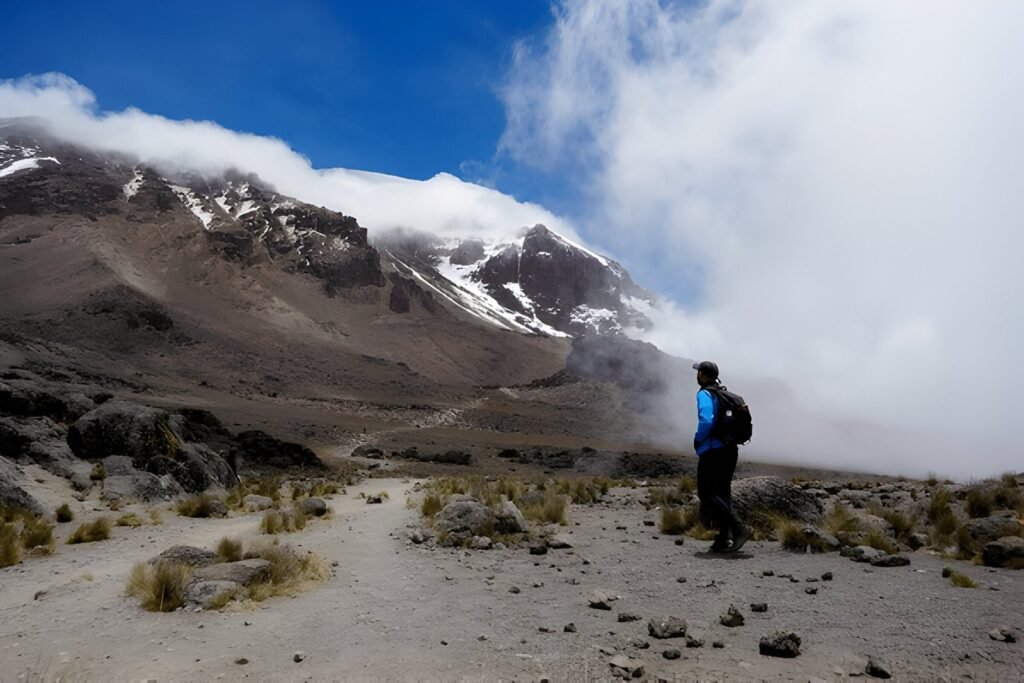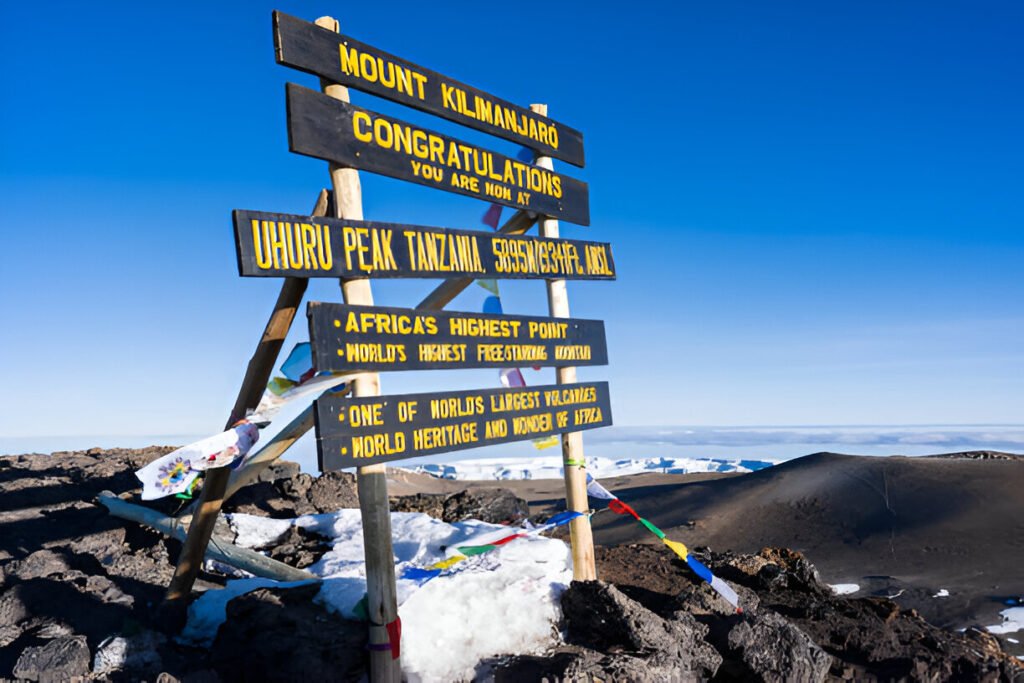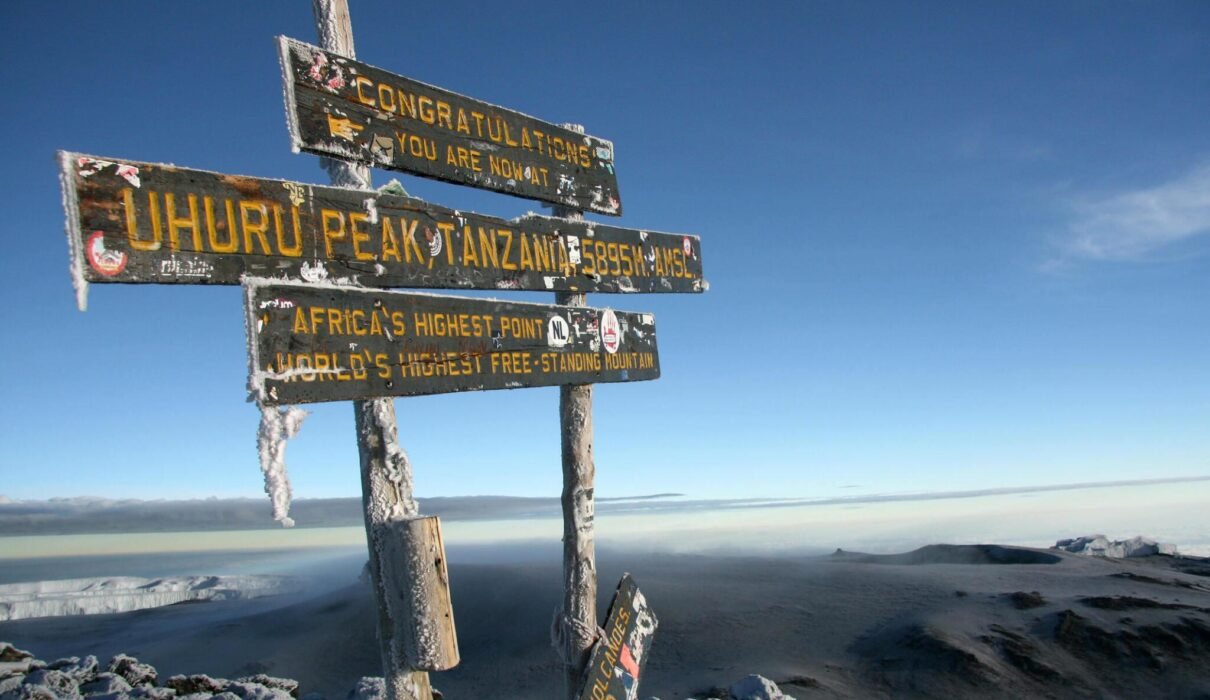Barranco Wall on Kilimanjaro : The Barranco Wall is one of the most famous and exhilarating sections of the Mount Kilimanjaro trek. It is often viewed as a daunting part of the climb, but with the right preparation, this steep wall can be conquered by most trekkers. Whether you’re planning your first ascent or are a seasoned climber, understanding what to expect on the Barranco Wall is key to a successful and memorable trek. In this guide, we’ll explore everything you need to know about tackling the Barranco Wall on Kilimanjaro, from tips and preparation to safety advice and route highlights.

Barranco Wall on Kilimanjaro : What is the Barranco Wall?
The Barranco Wall is a steep, rock face on Kilimanjaro, located at an altitude of approximately 4,200 meters (13,780 feet) on the Machame Route and Lemosho Route. Despite its intimidating appearance, the Barranco Wall is a non-technical climb, meaning you won’t need any special mountaineering skills or equipment. Trekkers will, however, need to use their hands for some scrambling to navigate their way up this vertical section of the mountain.
Learn more about Kilimanjaro’s routes and the Barranco Wall with Kilimanjaro Climb Specialist
Barranco Wall on Kilimanjaro : Why is the Barranco Wall Famous?
The Barranco Wall is famous not only for its steep ascent but also for the incredible views it offers. Climbing the wall provides breathtaking panoramas of the Kilimanjaro landscape, and upon reaching the top, trekkers are rewarded with stunning views of the Karanga Valley and the summit in the distance.
One of the biggest misconceptions about the Barranco Wall is that it’s dangerous or insurmountable. However, with proper guidance and a steady pace, most trekkers find the experience to be a highlight of their Kilimanjaro journey.
Barranco Wall on Kilimanjaro : How Difficult is the Barranco Wall?
The difficulty of the Barranco Wall is often exaggerated, but it does require scrambling—using both your hands and feet to climb certain sections. Trekkers need to be cautious and focused, but you won’t need ropes or technical climbing gear. The key is to follow your guide’s instructions, go at a steady pace, and stay mindful of the changing altitudes.
For those afraid of heights, the Wall can feel intimidating, as some sections have steep drop-offs. However, the trail is safe and well-marked, with guides assisting climbers where needed.
Check out expert tips for climbing Kilimanjaro with Eddy Tours Safaris
Barranco Wall on Kilimanjaro : Best Routes to Experience the Barranco Wall
Not all routes on Kilimanjaro include the Barranco Wall. If you’re eager to tackle this section, the Machame and Lemosho Routes are the best options. These routes are known for their scenic beauty and offer excellent acclimatization opportunities, which increases your chances of reaching the summit.
1. Machame Route
Known as the “Whiskey Route,” the Machame Route is one of the most popular and scenic paths up Kilimanjaro. It offers trekkers the chance to experience the Barranco Wall on the fourth day of the climb.
2. Lemosho Route
The Lemosho Route approaches the Barranco Wall after several days of trekking, giving climbers plenty of time to acclimatize. It’s a great choice for those looking to enjoy the diverse landscapes and spend more time on the mountain.
Discover the best Kilimanjaro routes with this detailed guide
Barranco Wall on Kilimanjaro : How to Prepare for the Barranco Wall
While the Barranco Wall doesn’t require technical climbing skills, it’s important to be physically and mentally prepared. Here are some key preparation tips:
1. Physical Fitness
Trekkers should be in good physical condition, with a focus on strength training and cardiovascular fitness. Exercises like hiking, cycling, and strength workouts will prepare you for the physical demands of scrambling up the wall.
2. Acclimatization
Proper acclimatization is essential for your Kilimanjaro trek, especially when approaching high-altitude sections like the Barranco Wall. Opt for longer routes like Lemosho or Machame that allow more time for your body to adjust to the altitude.
3. Mental Preparation
The thought of climbing the Barranco Wall can be daunting, but with the right mindset and guidance, it becomes an exciting challenge. Trust your guides, take it one step at a time, and don’t rush.
Barranco Wall on Kilimanjaro : Safety Tips for Climbing the Barranco Wall
Safety should always be a priority on Kilimanjaro, and while the Barranco Wall is safe for most trekkers, here are some safety tips to keep in mind:
1. Follow Your Guide
Your guide knows the safest and most efficient way up the Barranco Wall. Always follow their lead and listen to their instructions.
2. Go Slowly
It’s tempting to rush up the wall, but it’s important to pace yourself, especially at high altitudes. Pole pole (slowly, slowly) is the mantra on Kilimanjaro.
3. Watch Your Step
Be mindful of where you place your feet and hands, particularly on narrow sections with steep drop-offs. Focus on your immediate path rather than looking down at the heights.
Check out safety advice for trekking Kilimanjaro

Barranco Wall on Kilimanjaro : FAQs
1. Do I need climbing experience to tackle the Barranco Wall?
No, the Barranco Wall does not require technical climbing skills, but it does involve scrambling and using your hands to pull yourself up certain sections.
2. Is the Barranco Wall dangerous?
While the Barranco Wall may look intimidating, it’s generally safe for trekkers with basic fitness. Follow your guide’s instructions and take it slow.
3. What should I bring for the Barranco Wall section?
Good hiking boots, gloves for better grip, and layered clothing for warmth are essential. Make sure to stay hydrated and eat well to maintain your energy.
Barranco Wall on Kilimanjaro : Ready to Conquer the Barranco Wall?
Climbing the Barranco Wall on Kilimanjaro is one of the most exhilarating and rewarding experiences of the trek. While it may seem challenging at first, with the right preparation and guidance, you’ll conquer this iconic section with ease and continue your journey toward the summit of Africa’s highest peak.
Start planning your Kilimanjaro adventure with Kilimanjaro Climb Specialist
Book your trek with Eddy Tours Safaris

